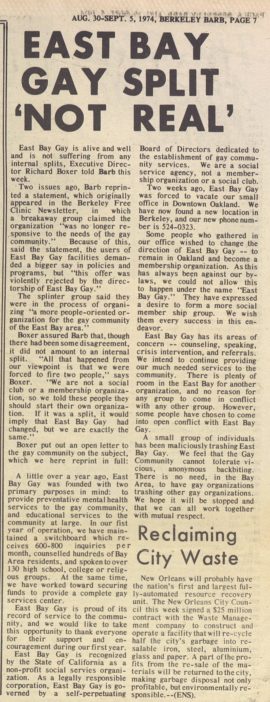In a moment of ‘growing pains’ for East Bay Gay, Executive Director Richard Boxer responded to charges, leveled by users of the organization, that it was “no longer responsive to the needs of the gay community.”
It’s hard to know for certain, from these documents, what was at the heart of the friction between these users of the organization and those who were running it. But it seems that the two groups had different visions of the organization’s function and process. The breakaway group hoped to have a more “people-oriented organization for the gay community,” one where the users of services would have a “bigger say in policies and programs.”
Richard Boxer replied that East Bay Gay was, at its heart, a “social service agency,” one which provided “preventative mental health services to the gay community” and “educational services to the community at large.” He wished the dissenters well in creating a “more social membership group,” but held fast to what he perceived as East Bay Gay’s “areas of concern”: “counseling, speaking, crisis intervention, and referrals.” As a service provider, Boxer implied, East Bay Gay might be best run largely by those professionals and paraprofessionals who were providing counseling and organizing the speakers bureau, rather than by the people using those services.
Boxer’s letter in defense of East Bay Gay also included some choice statistics that spoke to the ongoing impact that the organization was making. In its first year, its switchboard had received 600-800 calls per month; its speaker bureau had sent speakers to over 130 high school, college and religious groups; and it had provided counseling to hundreds of Bay Area residents.
This controversy erupted at the same time that East Bay Gay was relocating to Berkeley — and is linked, chronologically, to the organization’s adoption of the name “Pacific Center for Human Growth.”
